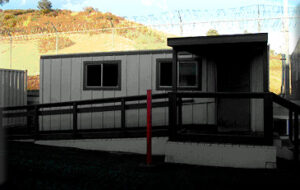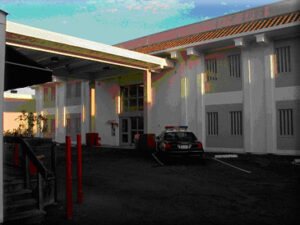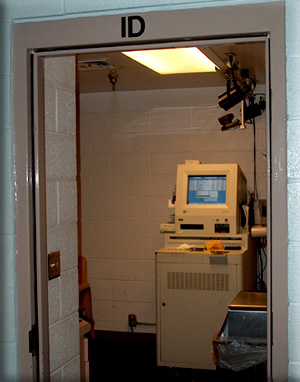The Arrest in Santa Barbara
Four types of DUI arrests are likely to be encountered by the Santa Barbara motorist. Phases described here follow the terminology in the NHTSA DWI Detection and Standardized Field Sobriety Testing Manual.
Where the Officer Observes Driving
Phase I: Vehicle in Motion
This kind of arrest begins when a police officer observes driving behavior she considers suspicious. When you see an officer in your rearview mirror (especially after 10:00 pm on Fridays and Saturdays), you are most likely being evaluated for a potential DUI stop.
Ideally, officers are trained to look for 27 cues for cars and 14 for motorcycles that suggest an impaired driver or rider. These cues include such things as drifting, swerving, weaving and braking erratically.
The officer must decide in Phase I whether to stop the vehicle or motorcycle. If the officer makes a stop, there are six impairment cues she will look for in the way the driver or rider makes the stop. These cues include sudden stops, a slow response and striking the curb during the stop.
Phase II: Personal Contact (driver still in car)
This is when the officer approaches the car, observes you, and interviews you while looking for signs of impairment. You are being observed from the moment you stop your car.
Ideally, officers are trained to look for 16 different signs of alcohol and/or drug influence, including bloodshot eyes, soiled clothing, slurred speech, the odor of an alcoholic beverage and “cover up” odors like breath sprays.
In addition to his observations, the officer may attempt to divide your attention between two task to show that you were impaired. Officers are taught to give you an instruction and then deliberately try to distract you from following it. If they are successful, they will testify that you were impaired.
Some officers will give certain nonstandardized “tests,” such as reciting the alphabet from “E” to “P” or counting backwards from 68 to 53. While there is no scientific evidence to link poor performance on the “tests” with impairment, the officer is usually allowed to testify to just that.
The officer must decide in Phase II whether to ask the driver to step out of the car or off the motorcycle. If the officer asks you to get out of the car, there are seven impairment cues she will look for. These cues include “climbing” out of the car, leaning against the car and leaving the vehicle in gear.
Phase III: Pre-arrest Screening (driver out of car)
Though the officer in Phase III must decide whether to arrest the motorist for DUI, once he is asked out of the car, chances are overwhelming that he will be arrested. The officer has very likely made up her mind already to make an arrest.
Ideally, officers are instructed to do three standardized field sobriety tests to measure your mental and physical impairment. These three tests are the walk and turn test, the one leg stand and the horizontal gaze nystagmus test. You are not required to submit to these or any other FSTs.
No other field sobriety test has any scientific validation to link poor performance with a particular BAC or impairment. For this reason, CHP officers are trained to do all three of these tests “wherever practical.”
These tests are notoriously unfair. You are instructed to do things that are not counted toward your score, and you are scored on things you are not told will count.
The officer may also ask you to complete a preliminary breath test (PBT), a preliminary alcohol screening (PAS) test in California. You are not required to submit to this test.
Where a Citizen Informant Reports Driving
This kind of an arrest begins not with the officer’s observations of driving, but with a citizen’s call to police. Depending on when the officer first encounters the motorist, there may or may not be a Vehicle in Motion Phase or an Initial Contact Phase.
There are potentially several challenges a competent DUI attorney can make to an arrest of this type, including a Fourth Amendment challenge to the stop and a statutory challenge to an arrest not made in the officer’s presence.
There are times when a motorist is at home when an officer attempts to make an arrest. Absent a warrant, police cannot force their way into the motorist’s home, although An officer may not arrest a motor
If there is a Vehicle in Motion Phase or Initial Contact Phase, the procedures are identical to those where the officer observed driving.
Where Police Set up a Roadblock or Checkpoint
Phase I: Vehicle in Motion
There is rarely much opportunity for an officer to observe the vehicle in motion at a checkpoint. When the officer does observe driving, it is usually good driving, as motorists are on their very best behavior.
Phase II: Initial Contact
As in Phase I, the initial contact at a checkpoint can be very helpful to the motorist. There is often time for the motorist to collect his thoughts and get his driver’s license & registration ready, making a good impression on the officer.
If the officer smells alcohol on a motorist’s breath, the statistics show the motorist will be arrested. It is thus in a roadblock case where the motorist has the most to gain by asserting her right not to incriminate herself.
Phase III: Pre-arrest Screening
This phase mirrors exactly the pre-arrest screening in the other scenarios.
Where there has been an accident
In an accident case there may be one, two or no phases if driver is found unconscious. In such a case, the driver is likely to be taken to a hospital where a blood test will be performed, either at the arresting officer’s request or as part of the patient’s medical treatment.
Patient treatment should be confidential under the new federal HIPAA laws. If a blood test is ordered as part of treatment to determine the patient’s BAC, it should not be made available to the police or prosecutor.
What Happens Next
blood or breath test
Under California’s implied consent law, a motorist arrested for DUI must take a chemical test to measure the amount of alcohol in his blood. You must choose between a breath test or blood test if either one is available. If neither one is available, you must take a urine test to satisfy the implied consent law.
In the Santa Barbara County Jail, you will be taken to this trailer for your chemical test.

If you refuse to complete one of these tests (or have so much difficulty completing it that the officer deems you to have refused it), you will be cited as having refused the test. DMV will then suspend or revoke your license, depending on your number of previous offenses. If you are ultimately convicted of DUI, your sentence will be increased because of the refusal.
Booking
After the chemical test, you will taken through these doors at the Santa Barbara County Jail and into a booking cell.

Booking is the process law enforcement uses to register and enter charges against a person believed to have violated the law. The booking process includes recording your personal information and description, photograph (also known as mug shot), fingerprinting, and a Department of Justice records check.
In the Santa Barbara County Jail, the identification process is completed next door to the booking room in the ID room:

Additionally, all personal property and money will be taken from you, itemized, and placed into custody. You will also be asked a series of medical questions to evaluate your physical and mental health.
Unless you are required to post bail, you will be released upon your written promise to appear in court and answer the allegations of DUI. You make that promise by signing a citation like this one.
Bail
In some cases the arresting officer or her supervisor determines that a suspect is a flight risk and requires bail to be posted before the suspect is released. In Santa Barbara County, bail is usually required for out-of-state residents and drivers without proper documentation.
Bail is a cash deposit or bond posted with the arresting agency or court to guarantee the suspect’s appearance in court. If the suspect does not appear in court, the bail is forfeited to the court.
Rather than depositing the funds with the agency or court, most DUI suspects hire a bail bonds company to post a bond instead of the cash deposit. The company typically charges a 10% fee to post the bond, which is nonrefundable.
